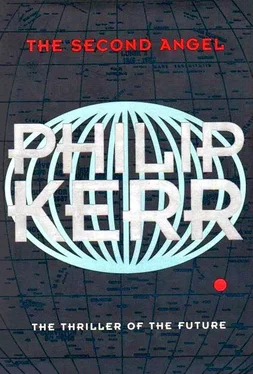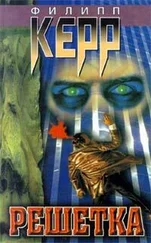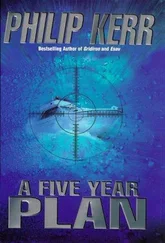Standing there in the open payload bay, Gates had his first real opportunity to have a good look at the First National’s main facility — during the landing he’d been too busy trying not to crash the RLV to spend any time admiring Dallas’s apparently impregnable design. The main facility was located about a quarter of a mile to the west of the landing site, at the end of a flat road about ten yards wide and several hundred yards long. Both the landing site and the main facility were enclosed by a series of high-voltage fences powered by a field of photovoltaic cells that lay about a hundred yards beyond the perimeter wire to the south. And in the distance, he could see the rim of the surrounding Descartes Crater, where the surface-to-air missile systems protecting the First National and its precious supplies were mounted. The main facility building itself was completely circular and gently vaulted, so that the whole thing looked like the shell of a sea urchin. Ostensibly constructed of one giant dome of breccia-concrete and painted gold to protect the deep-frozen contents against the heat of the bright sunlight, the construction was, as Dallas told Gates, actually composed of a series of concrete shapes that met three to a vertex.
‘It’s a design that was inspired by the Eskimo igloo,’ he said, ‘in that the structure is held up by the rigidity of local planar areas.’
They were using an encrypted frequency to avoid being overheard by the Descartes computer.
‘Very impressive, I’m sure,’ said Gates, who had no more idea of what an igloo looked like than he did of the Eskimo who built one. He pointed to the area of soil and rocks that lay on either side of the landing site and the golden road that led to it. Dallas had already told him that unauthorized road users would be electrocuted. ‘What happens down there?’ he asked. ‘Why not forget about the road and walk across the dirt?’
‘Because of the solar-powered seismographs,’ said Dallas. ‘Very sensitive. And the minefield they control. You wouldn’t get ten yards. Take my word for it. The road is the best way.’
Dallas pointed to where the road led into the main facility. ‘That’s where our transport will be coming from. Come on. We’ve got to get properly chilled before we can take our seats.’
‘Get chilled or get killed,’ grumbled Gates, as he followed Dallas along the floor of the payload bay, using the handrail to steady himself as he went. Near the back of the bay, each man collected a backpack containing all the equipment he would need inside the facility and then jumped over the side of the Mariner.
Both men heard Prevezer’s voice on their headsets as they bounced their way across the landing area to where the Mariner’s robot arm had placed the space fridge.
‘Descartes just told us the blood wagon’s on its way,’ he said. ‘And so are we. We’re entering the airlock now, to suit up.’
‘Give us ten minutes in the space fridge, and then pull us out,’ Dallas told Prevezer. ‘Then proceed as planned.’
‘Roger, that.’
As they walked the few yards to the space fridge, each man drew down his helmet’s gold-painted outer visor to reflect the lunar Sun’s unfiltered glare. On the Moon, a morning lasts for seven days. It takes a whole week for the Sun to climb to its zenith in the black sky, and another week for it to set again, before vanishing behind the western horizon. So close to the lunar equator as Descartes was, Moon temperatures could climb as high as one hundred and ten degrees Celsius (225°F), while at night they could drop as low as minus one hundred fifty-two degrees Celsius (—243°F). It was now 7:30 P.M. local Moon time, and with the whole crater still bathed in bright sunshine, the evening temperature on the landing site was over one hundred degrees Celsius. In the heat, Gates was glad of his water-cooled underwear, although he was acutely aware of just how cold he was about to get.
‘Wouldn’t this have been easier at night?’ he asked. ‘I mean, cooling down ’n’ all?’
‘Much easier,’ agreed Dallas. ‘But how would you like to try and make that landing in near darkness?’
‘You have a point,’ conceded Gates. He opened the door to the fridge and stepped into its cold, dark interior. ‘Shit, I wouldn’t like to make that landing again in a goddamn simulation.’
Dallas followed Gates inside the fridge, flipped up the golden visor, and switched on his helmet lights to illuminate the fridge before closing the door.
Two large heavy-duty polyethylene bags were waiting for them, tethered to the wall of the fridge and spread open like waiting pupae. Backing into one of the bags, Gates zipped it up from the inside and then sat down on an empty cryoprecipitate storage unit. He shook his head and checked his watch, shivering as the near absolute zero temperature of the fridge began to permeate his body bag. ‘Remind me why we’re doing all this ice-cube business again, Dallas.’
Zipped inside his own body bag, Dallas sat alongside him. ‘You know why we’re doing this.’
‘Yes, but it’ll make conversation while we simulate getting hypothermia and freezing to death.’
‘Prevezer’s keeping a close eye on our vital signs in the real world,’ insisted Dallas. ‘He’ll end the simulation if he thinks we’re in trouble. Besides, a hypothermia victim is never dead, only cold. Fact is, you can demonstrate all the clinical signs of death and still be revived. It’s a condition called metabolic icebox.’
‘That’s now. But who’s going to look after us when it’s time for the real deal?’
‘This is a necessary risk,’ explained Dallas. ‘That is, if we want this stage of the plan to succeed.’ He shivered as cold began to permeate his body. Then the fridge gave a shudder and produced a dull mechanical noise.
‘What was that?’ asked Gates.
‘Helium isotopes venting into space,’ said Dallas. ‘It means that the fridge is doing its job properly. Drawing heat away from us efficiently.’
‘That’s comforting,’ trembled Gates.
‘It ought to be. Might be kind of unpleasant for us if our surface temperature stays too high.’
‘That’s what I meant to ask you, Dallas. In what way unpleasant? You didn’t say.’
‘You really want to know?’
‘In case you hadn’t noticed, I’m already living dangerously.’
‘Okay, you asked for it. Prev and Sim will fetch us out of here and carry us to the electric blood wagon. That way the car’s microwave motion detectors will collect only two approaching body signals. Shouldn’t be too difficult for them. Even carrying a big ox like you. Neither of us weighs more than thirty to forty pounds in one-sixth g.
‘They’ll dump us inside one of the cars, collect the units of blood for Ronica, close the lid of the car, and then move away again. The car computer checks for two retreating signals — Prev and Sim — and then heads back down the golden road to Samarkand. If there aren’t two retreating signals, then Prev and Sim are in big trouble. The computer fires a laser called a Dazer. Even from behind a sun visor it’s more than enough to blind you. Then they’d probably wander off into the minefield and goodbye both.’
‘The hell with their comfort and convenience,’ said Gates. ‘What about us?’
‘All units of cryoprecipitate have to be stored at minus one hundred and twenty degrees Celsius. Stored and transported to the First National’s own RLVs. Each refrigerated car is equipped with a thermal heat sensor to protect the integrity of the cryoprecipitate being transported.’
‘Right,’ grunted Gates, who was shivering all the time now. According to the readout on his life-support system computer, his core body temperature had already dropped below normal. ‘ ’S why we’re in here, I know all that.’
Читать дальше












